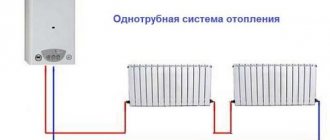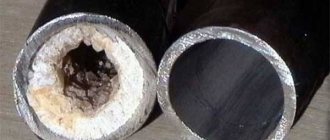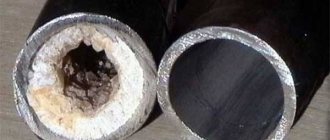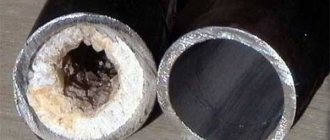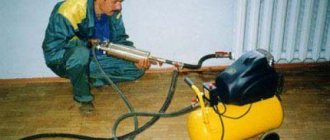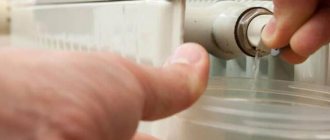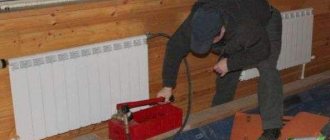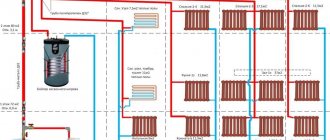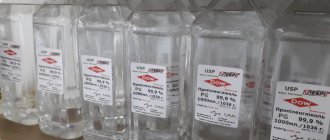Flushing a heating system is the removal of internal contaminants from pipes, radiators, fittings, and boiler equipment.
- Why flush your heating system?
- When should you flush your heating system?
- Methods for flushing the heating system
- Flushing the heating system in an apartment building
- Flushing the heating system in a private house
- Cost of flushing a heating system
- Heating system flushing act
- Flushing the heating system yourself
Why flush your heating system?
Why flush your heating system?
- to reduce heating costs,
- to improve the efficiency of the heating system,
- to increase the service life of heating equipment,
- to reduce the risk of emergency situations.
- In the heating system, salt, silt and sand are deposited on the walls of pipes, radiators, shut-off valves, boilers, and heat exchangers.
The coolant liquid (hot heating water) brings all this to the heating systems.
Year after year, the layer of deposits becomes thicker, and every millimeter of dirt reduces heating efficiency by 10-15%.
Deposits on the walls harden and are then more difficult and expensive to remove.
As a result, heating costs rise and the temperature in the building is below the required minimum.
In a neglected situation, scale deposits in the heating system lead to accidents and failures.
This is what it looks like:
When should you flush your heating system?
The heating system must be flushed before the start of the heating season.
This is routine maintenance to keep your heating system in good working order.
Regular flushing of the heating system allows you to use inexpensive cleaning methods.
Bulk and old deposits will have to be removed using specialized washing equipment.
Scheduled flushing of the system increases the trouble-free service life of the heating system several times.
After installation, major repairs, as well as routine repairs with replacement of pipes, it is also necessary to test and flush the heating system.
The timing and methods of carrying out mandatory flushing of heating systems are defined in the following documents:
- “Rules for assessing readiness for the heating season” (approved by Order of the Ministry of Energy of Russia dated March 12, 2013 N 103);
- “Rules and norms for the technical operation of the housing stock” (approved by Resolution of the State Construction Committee of Russia dated September 27, 2003 N 170);
- “Rules and norms for the technical operation of the housing stock” (approved by Resolution of the State Construction Committee of Russia dated September 27, 2003 N 170);
- “Rules for the technical operation of thermal power plants” (approved by order of the Ministry of Energy of the Russian Federation dated March 24, 2003 N 115)
Inspecting radiators using a thermal imager
Unscheduled flushing of the heating system must be carried out:
- when heating efficiency decreases (hot coolant is supplied to the input, and the batteries are cold);
- in case of uneven heating of the radiators (in this case, it is necessary to exclude the presence of an air lock in the radiators);
- reduction in system capacity due to contamination.
To determine accurately, you need to do an inspection of the heating system.
The easiest and fastest way to inspect the heating system and radiators is with a thermal imager.
The examination will determine the thickness and chemical composition of the deposits.
After this, we select the appropriate washing method.
Now we’ll talk about ways to flush the heating system.
Selection of communal and individual meters
The most profitable option for metering heat input would be to install a common house meter. In this case, the residents of the house decide to purchase and install it. The device will be connected to a common pipe that supplies heating to the entire building. Although the cost of a heating meter for general house use is quite high, the cost for apartment residents in the end will not be so significant. The readings received are divided by the number of residents, and the payment itself will be made by a person specially selected at the meeting.
If there is no agreement among the tenants, then it makes sense to install a heat meter for heating in the apartment.
It will help you save money when paying for housing and communal services. The price of such a device is lower than that of a meter for general household needs. Purchase, installation and maintenance fall entirely on the shoulders of the home owner. But the advantages of heat metering will be immediately visible. The purchase will pay off and bring profit in the future. Date: September 25, 2022
Water hammer method of flushing the heating system
the hydraulic shock (or hydromechanical) method for flushing heating systems of short length (private house, small apartment building).
For minor stains, this method can also be used for large buildings.
For the water hammer method, we connect a pump, which not only ensures circulation in the system, but creates a series of water shocks of the coolant.
Water hammer method of flushing the heating system
Under the influence of water hammer, deposits on internal surfaces are destroyed and then washed away by the flow of water into the sewer.
Water absorbs impact energy well, so the load on the walls of pipes, fittings and radiators is small.
If your heating system is in good working order, there is little risk of damage or leaks.
For preventive cleaning of the heating system, this method is sufficient.
To remove more complex contaminants, other washing methods are used.
Now we will tell you about them.
Hydropneumatic method for flushing a heating system
The hydropneumatic method is the main method for flushing heating systems of apartment buildings and large buildings.
For such flushing, we will install a pump with a compressor that will circulate the coolant and supply the required amount of air to the system.
The air-water mixture bubbles in the heating system and actively destroys stubborn deposits.
Hydropneumatic method for flushing a heating system
All contaminants are also washed out of the system by the flow of water.
This method of flushing the heating system is suitable for removing contaminants even from old cast iron radiators.
The cavitation flow of water lifts contaminants even from hard-to-reach areas of the system.
The hydropneumatic method puts less stress on pipes and fittings, but requires the connection of expensive flushing equipment.
There is another way - chemical.
With the chemical method, everything is more complicated, but let's take it in order.
Is it possible to wash a separate battery?
Now you know how to flush the heating system. However, sometimes it becomes necessary to clean a separate battery. There is a solution for this situation too.
Heating battery cleaning scheme
Buy a flushing faucet from a plumbing store. Additionally, you need to purchase a rubber hose and a fitting with a thread that matches the diameter of the purchased flushing valve. Install the fitting onto the hose.
Direct washing is carried out in the following sequence.
First step. We connect the flushing tap to the heating radiator.
Second step. We connect a fitting with a hose to the flushing tap.
Third step. We direct the second end of the rubber hose into the toilet.
Fourth step. Open the flush tap and leave for 20-30 minutes. While waiting, hold the hose so that it does not jump out of the toilet.
Chemical method of flushing the heating system
For this method we need special chemistry (acid, alkali).
We add the reagents to the coolant and connect the circulation pump.
The liquid passes repeatedly throughout the system, the chemistry dissolves contaminants.
It is necessary to select the chemical composition of the reagents in accordance with the type of contaminants, material of pipes and heating radiators.
You also need to accurately calculate the flushing time so as not to damage the inner surface of the heating system.
Chemical method of flushing the heating system
The difficulty of the chemical method is that after treatment it is impossible to drain the coolant with washed dirt and chemicals into the sewer.
Aggressive chemicals must be disposed of in a special way.
After chemical treatment, the system is thoroughly washed with running water - the chemical must be removed from the system.
After flushing, we will check the system for leaks - we will test it with pressure.
There is always a possibility of failure of heating system elements (areas with severe corrosion).
Depending on the size and complexity of the heating system, we select the flushing method and the order of work.
Let's give a few examples.
Radiator cleaning
An important point is regular flushing of heating radiators
Sometimes it is necessary to clean one of the main elements of the system - the radiator. This is immediately noticeable by the fact that it does not warm up to the required temperature, compared to neighboring batteries. To do this, you need to carry out a number of activities that are carried out before the heating season.
- To begin with, the coolant is drained from the system and the radiator is dismantled.
- You can wash the battery at home by placing it in the bathtub. First you need to cover it with a thick layer of fabric or old things, which you can then simply throw away. This is necessary in order not to spoil the enamel coating of the bathtub.
- All plugs are removed from the battery. Don’t forget to install a mesh over the drainage hole to make it easier to collect loose deposits coming out of the radiator.
- The watering can is removed from the shower hose, and the water from it is directed into the radiator under maximum pressure. The radiator is sometimes turned to drain all the water and deposits.
- In addition to the stream of water, you can add a piece of reinforcement, which will help clean off large build-ups.
- If it is possible to carry out this event on the street, then it is better to do this using a long hose that can be inserted anywhere deep into the battery.
- When the water from the battery begins to flow clear and clean, it can be installed back.
- After installing the radiator and installing all its parts on the seals, it would be useful to carry out a control pressure test. Only now will the work be considered complete and the system can be filled with water.
If the time has come to clean the heating system or its individual elements, correctly assess your strength. It may be better to call a specialist who will quickly cope with this task and perform it competently than to risk your property or the property of your neighbors. If the system is assembled incorrectly after cleaning, you may end up with more than one leak that will be difficult to quickly repair.
Flushing the heating system in a private house
In a private house, closed heating systems are mainly installed.
If the pipes are filled with prepared coolant (desalinated and purified water, antifreeze), then little pollution is formed in such a system.
For prevention, a hydrodynamic method is sufficient.
Before flushing, we will study the documentation for the heating system, carry out diagnostics and suggest an appropriate method.
Flushing the heating system in a private house
In autonomous heating systems, water heating devices are used - these are various boilers.
The coolant in the boiler heats up, and it is in the heating areas that the main contaminants are formed.
The efficiency of boiler equipment when there is contamination inside the system drops several times.
Fuel costs are rising, and heat is becoming less and less.
There is only one way: to inspect the heating system and flush it.
Pipes and radiators are now mostly made of plastic and aluminum alloys, and there is little rust in such systems.
It is important that the heating is closed, with a membrane-type expansion tank.
It is also important that prepared water with a low salt content is used as a coolant.
If these conditions are met, you can flush the heating system of a private home much less often.
Often it is enough to rinse it with running water once every few years.
Flushing the heating system in an apartment building
Video description
This video shows why the pressure in the circuits may drop
Open systems with air
Air testing can be used to test open heating systems. Most often, an expansion tank is used to create pressure in private areas, and the pressure in the system when using it is 1 bar. Therefore, for testing, this parameter will be 2 atmospheres, which can be pumped up using a conventional hand pump.
Before performing the test, all liquid from the system must be drained (preferably into a separate container for reuse) and the pipes must be flushed. After cleaning, all water must be drained and tightly closed all places through which air can be released, for example, Mayevsky taps. It is also necessary to close the inlet pipe that leads to the tank. After this, you should connect the pump to the system through a special fitting using a hose, which is recommended to be secured with clamps, and begin to apply pressure.
Open heating circuit Source izion.pro
Flushing the heating system in an apartment building
A large house means a large heating system.
Such systems may have several circuits and many fittings.
We flush the heating system of an apartment building after studying the design documentation.
Depending on the system configuration, we flush the entire system or individual circuits, blocking the fittings.
Heating flushing price
Documents for crimping
To carry out pressure testing of the system, you must have a plan, which is reviewed and signed by the chief engineer of the company that supplies heat. This document determines the sequence in which the inspection will be carried out, as well as what employees should do during the process. Also, after all checks, a pressure testing report must be drawn up, which describes:
- what verification method was used;
- the project for which the heating system was installed;
- the date of the tests, the address of the place of conduct and the names of those people who sign this act;
- what methods were used to fix leaks or problems in the circuit;
- test result;
- the presence of places that violate the tightness of the system and the formation of condensation on fittings or pipes.
After all checks, the act should be checked for errors or inaccuracies, and then signed. There is also a schedule for flushing and pressure testing the heating system, a sample of which can be seen below.
Pressure testing schedule Source yolatec1.ru
Heating flushing price issue
The price for flushing the heating system is determined based on the following data:
- length of the heating system;
- system configuration (contours, floors);
- presence of heat exchangers;
- level of system contamination;
- materials of pipes and radiators;
- method of flushing a heating system.
To find out the exact cost of flushing your building, give us a call.
We will advise you and inform you of the exact cost of all work.
Heating system flushing act
We have already said that flushing the heating system is a responsible procedure.
To perform flushing efficiently, you need flushing equipment, chemical reagents and experienced personnel.
Flushing the heating system is a necessary procedure for long and trouble-free operation.
Based on the results of the work, we will issue a “Heating System Flushing Certificate”
Here's what it looks like:
Act dated “___” _________ 20 ___ flushing heat consumption systems
Object____________________________________________________________ Address____________________________________________________________
We, the undersigned:
subscriber representative_______________________________________________ (position, full name, phone number)
have drawn up this report stating that “___” ___________ 20 ____ the heat consumption system of the facility was flushed.
Washing method:
- hydropneumatic
- hydromechanical
- using chemicals
Meter readings before flushing _______ after flushing ________
The quality of washing is recognized _____________________________________
Subscriber representative ___________________________/______________/
Head of the subscriber's enterprise_________________/______________/
The heating system flushing report should contain the following information:
- address of the heating system location and its type;
- washing method;
- materials used and their volume (water, chemicals);
- date of work;
- washing result;
- signatures of the parties.
It remains to tell you a little: is it possible to flush the heating system yourself?
Do-it-yourself heating flushing
Flushing the heating system yourself
You can flush the autonomous heating system of a private house yourself.
For the heating system of an apartment building (as well as a business center, school, kindergarten, enterprise), it is necessary to involve a heat supply organization and specialists.
A small heating system can be flushed with running water after the end of the heating season.
To do this you need to know the system configuration.
Private houses have the simplest systems of pipes, a boiler and radiators.
There are also multi-circuit underfloor heating systems with several circuits, collectors and complex fittings.
The task is not only to flush the system, but also to fill it correctly after completing the work.
It is important to prevent the presence of air pockets in the system - this will disrupt the circulation of the coolant.
A simple system is flushed with water until clean water comes out of the drain tap.

